 Technology peripherals
Technology peripherals
 AI
AI
 How to use artificial intelligence correctly? UCL and Newcastle University release guide to using AI!
How to use artificial intelligence correctly? UCL and Newcastle University release guide to using AI!
How to use artificial intelligence correctly? UCL and Newcastle University release guide to using AI!

Unlike the vigilance and rejection when ChatGPT first became popular, many universities seem to have chosen to "peacefully coexist" with these emerging AI technologies.
Not only have they conducted relevant research on these technologies, they have also integrated ChatGPT into their courses and even allowed students to use them in their assignments.
But "peaceful coexistence" does not mean that students can abandon academic integrity and use these artificial intelligences unscrupulously.
Some universities in the UK have issued guidelines for the use of artificial intelligence. This is also to specifically guide students on how to use AI effectively and reasonably in their studies to avoid academic misconduct.
Today Xiao E will take several schools as examples to see what requirements British universities have for the use of artificial intelligence.
University College London

UCL stated that it will not try to prohibit students from using AI tools, but will support students to use them effectively, ethically and transparently. This guide is to explain to students how to use AI and how to show that they are using AI.
However, using AI to write a complete paper is not allowed, but using them to help generate some ideas or plans is appropriate.
The current controversial point is that the words and ideas generated by some artificial intelligence tools use the ideas of human authors without marking the source. Many people think that this itself is an act of plagiarism, Therefore, it is easy for students to fail to identify the true source of these ideas.
Therefore, UCL also lists the uses and limitations of AI tools.

In this regard, UCL mentioned aspects in which AI tools can effectively help students in learning, such as answering questions, drafting ideas or plans, improving grammar and writing structure, debugging code, etc. Obviously, schools hope that AI tools will only assist students, rather than letting students rely entirely on AI-generated content.

At the same time, AI also has a lot of limitations. They often make mistakes, provide false information, and the reference materials given are often fabricated content, and AI does not perform well in some areas.
Over-reliance on these tools is not conducive to students practicing writing and developing critical thinking, and their own development will also be affected.
How to indicate the use of AI in your content?
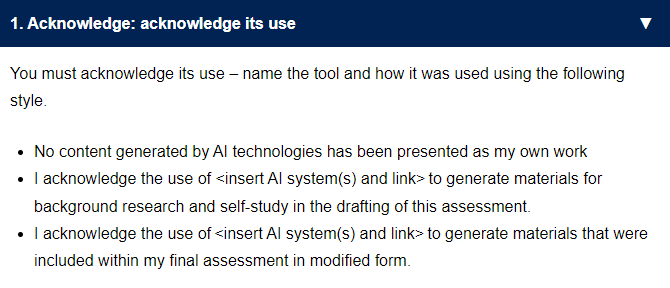
You need to acknowledge the use of these artificial intelligence tools, and write the names of the tools you use and how to use them in the format provided by the school.
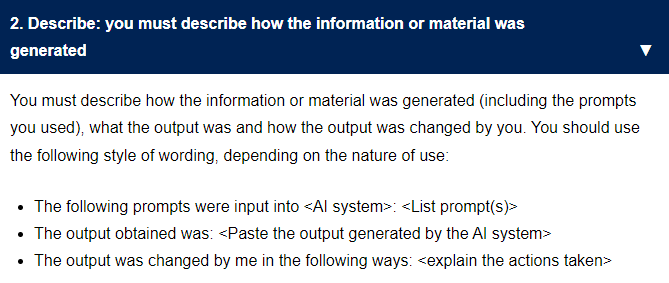
Secondly, you need to describe how the information and materials were generated. You must clearly describe what you input to the AI, what the AI generates, and what changes you made to the generated content.
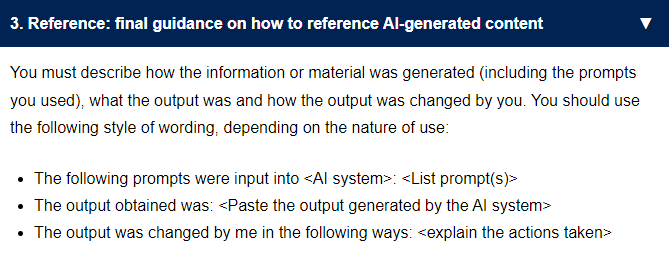
Similarly, the content given by using AI should also be listed as a reference.
Specific examples
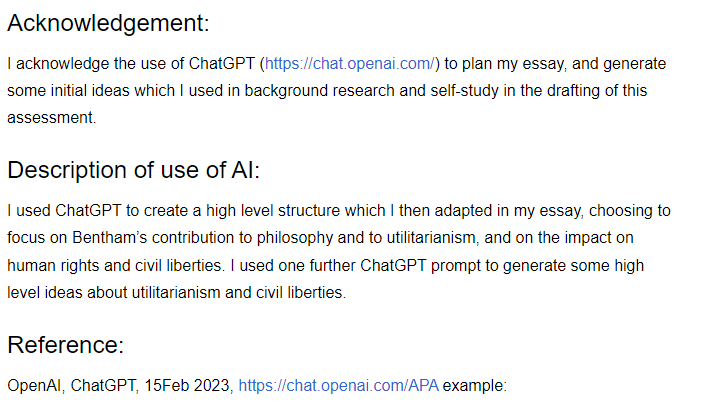
The above content applies to all UCL examinations and assessments, but you still need to follow the guidance of your teacher for the specific courses and assignments that can use these tools. So before using AI, you must confirm with your teacher which courses and assignments can use AI tools, and which tools can be used, and then follow this usage guide to use them reasonably!
Newcastle University
The official website of Newcastle University also gives a suggestion for the use of artificial intelligence. The basic format is similar to that of UCL.
1. List the artificial intelligence technologies used and summarize how you use them

2. Describe how the information or materials were generated

3. Reference example

In addition to the above, Newcastle University also lists a detailed description of the corresponding AI citation statement guidelines for nine paper formats.
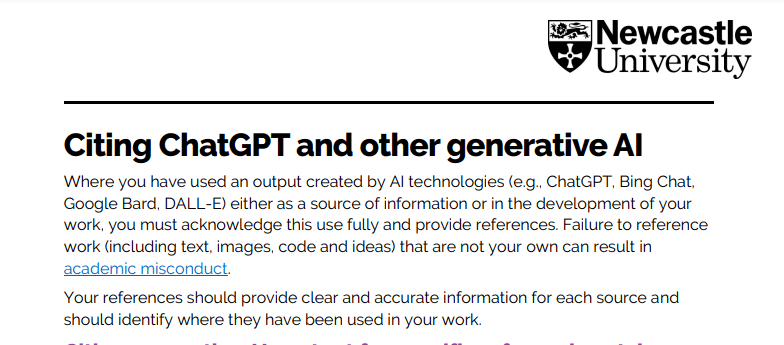
Under this trend, many schools are also beginning to write guidelines for the use of artificial intelligence.
 *University of Edinburgh: Instructing students on the use of generative artificial intelligence (such as ChatGPT)
*University of Edinburgh: Instructing students on the use of generative artificial intelligence (such as ChatGPT)
This guide from the University of Edinburgh emphasizes that if you use ChatGPT in your assignment paper, you need to indicate it. You need to confirm with your teacher which courses or assignments can use these tools.
Aida also mentioned the shortcomings of AI tools and once again stated that over-reliance on these tools will only be detrimental to its own growth.
However, this guide only mentions in general terms that if you use an AI tool, you need to clearly describe how you use it, the time of use, etc. But it does not specify the specific format like UCL. List it out.
This guide will continue to be updated, and students in Edinburgh can continue to pay attention.
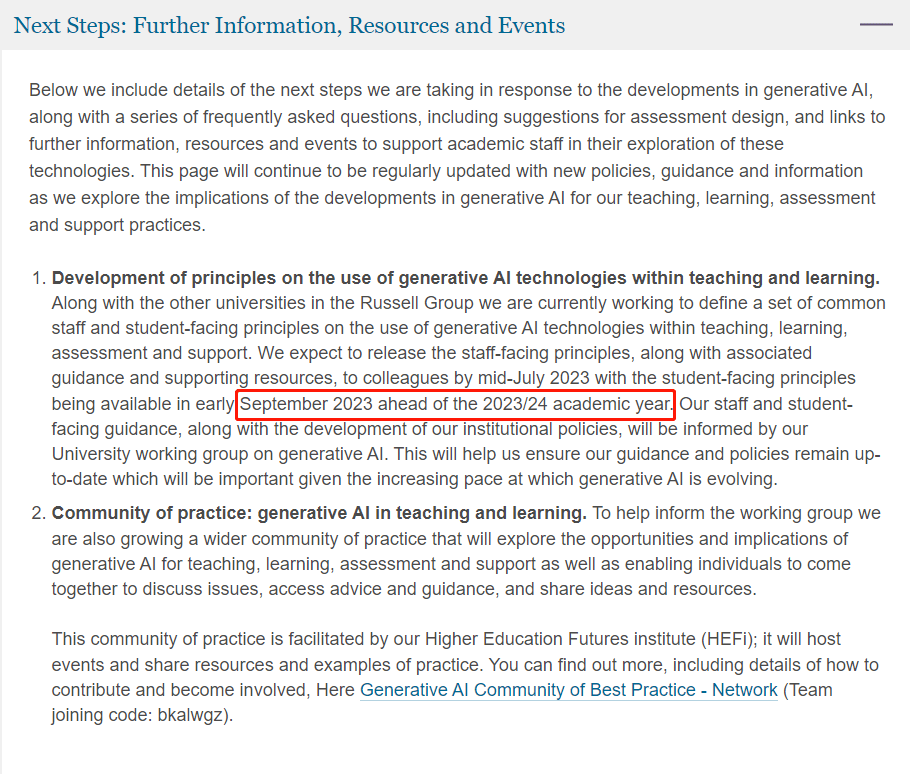
The University of Birmingham has not released relevant usage guidelines, but the school has also made it clear that it is formulating a set of principles for the use of artificial intelligence, which is expected to be released to all students in September this year.
Different universities have different requirements. You can go to your school's official website to check whether specific guidance methods have been released to see what the school's requirements are, and then use AI tools if the requirements are met.
The above is the detailed content of How to use artificial intelligence correctly? UCL and Newcastle University release guide to using AI!. For more information, please follow other related articles on the PHP Chinese website!

Hot AI Tools

Undresser.AI Undress
AI-powered app for creating realistic nude photos

AI Clothes Remover
Online AI tool for removing clothes from photos.

Undress AI Tool
Undress images for free

Clothoff.io
AI clothes remover

AI Hentai Generator
Generate AI Hentai for free.

Hot Article

Hot Tools

Notepad++7.3.1
Easy-to-use and free code editor

SublimeText3 Chinese version
Chinese version, very easy to use

Zend Studio 13.0.1
Powerful PHP integrated development environment

Dreamweaver CS6
Visual web development tools

SublimeText3 Mac version
God-level code editing software (SublimeText3)

Hot Topics
 1386
1386
 52
52
 I Tried Vibe Coding with Cursor AI and It's Amazing!
Mar 20, 2025 pm 03:34 PM
I Tried Vibe Coding with Cursor AI and It's Amazing!
Mar 20, 2025 pm 03:34 PM
Vibe coding is reshaping the world of software development by letting us create applications using natural language instead of endless lines of code. Inspired by visionaries like Andrej Karpathy, this innovative approach lets dev
 Top 5 GenAI Launches of February 2025: GPT-4.5, Grok-3 & More!
Mar 22, 2025 am 10:58 AM
Top 5 GenAI Launches of February 2025: GPT-4.5, Grok-3 & More!
Mar 22, 2025 am 10:58 AM
February 2025 has been yet another game-changing month for generative AI, bringing us some of the most anticipated model upgrades and groundbreaking new features. From xAI’s Grok 3 and Anthropic’s Claude 3.7 Sonnet, to OpenAI’s G
 How to Use YOLO v12 for Object Detection?
Mar 22, 2025 am 11:07 AM
How to Use YOLO v12 for Object Detection?
Mar 22, 2025 am 11:07 AM
YOLO (You Only Look Once) has been a leading real-time object detection framework, with each iteration improving upon the previous versions. The latest version YOLO v12 introduces advancements that significantly enhance accuracy
 Best AI Art Generators (Free & Paid) for Creative Projects
Apr 02, 2025 pm 06:10 PM
Best AI Art Generators (Free & Paid) for Creative Projects
Apr 02, 2025 pm 06:10 PM
The article reviews top AI art generators, discussing their features, suitability for creative projects, and value. It highlights Midjourney as the best value for professionals and recommends DALL-E 2 for high-quality, customizable art.
 Is ChatGPT 4 O available?
Mar 28, 2025 pm 05:29 PM
Is ChatGPT 4 O available?
Mar 28, 2025 pm 05:29 PM
ChatGPT 4 is currently available and widely used, demonstrating significant improvements in understanding context and generating coherent responses compared to its predecessors like ChatGPT 3.5. Future developments may include more personalized interactions and real-time data processing capabilities, further enhancing its potential for various applications.
 Best AI Chatbots Compared (ChatGPT, Gemini, Claude & More)
Apr 02, 2025 pm 06:09 PM
Best AI Chatbots Compared (ChatGPT, Gemini, Claude & More)
Apr 02, 2025 pm 06:09 PM
The article compares top AI chatbots like ChatGPT, Gemini, and Claude, focusing on their unique features, customization options, and performance in natural language processing and reliability.
 How to Use Mistral OCR for Your Next RAG Model
Mar 21, 2025 am 11:11 AM
How to Use Mistral OCR for Your Next RAG Model
Mar 21, 2025 am 11:11 AM
Mistral OCR: Revolutionizing Retrieval-Augmented Generation with Multimodal Document Understanding Retrieval-Augmented Generation (RAG) systems have significantly advanced AI capabilities, enabling access to vast data stores for more informed respons
 Top AI Writing Assistants to Boost Your Content Creation
Apr 02, 2025 pm 06:11 PM
Top AI Writing Assistants to Boost Your Content Creation
Apr 02, 2025 pm 06:11 PM
The article discusses top AI writing assistants like Grammarly, Jasper, Copy.ai, Writesonic, and Rytr, focusing on their unique features for content creation. It argues that Jasper excels in SEO optimization, while AI tools help maintain tone consist



